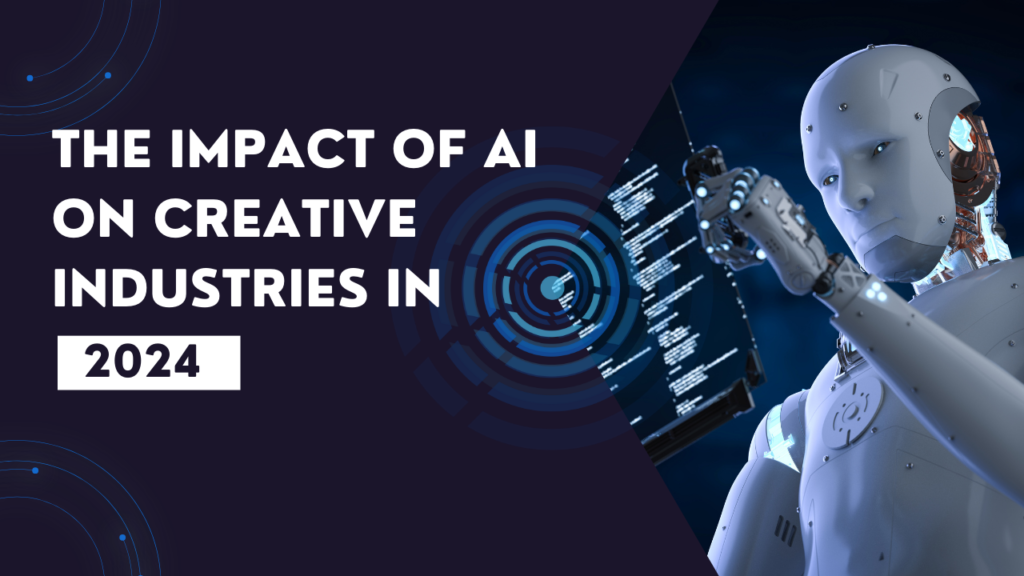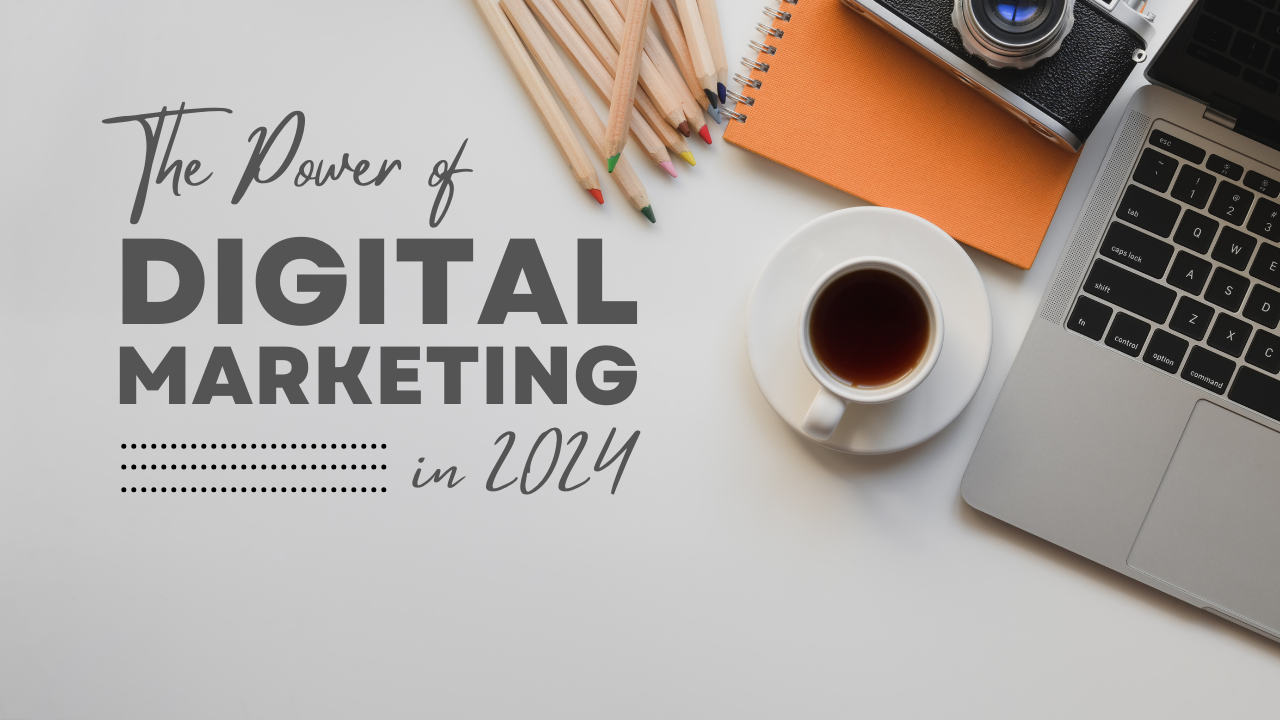The Impact of AI on Creative Industries in 2024

The Impact of AI on Creative Industries in 2024
While artificial intelligence (AI) is quickly changing many businesses worldwide, the creative industries—including writing, music, film, art, and design—are particularly affected. Creativity was traditionally thought to be limited to human ability and imagination, but machine learning algorithms and AI-driven technologies are changing this. We’ll look at the prospects, difficulties, and effects of AI on the creative sectors in this blog.
1. Artificial Intelligence in Design and Art
Creative Expression and Original Art
AI has made it possible for computers to create generative art, in which pre-established rules or data are used to generate artwork autonomously. Utilizing word prompts, programs such as DALL·E, RunwayML, and DeepArt produce amazing images. AI and artists are now working together to push the frontiers of creativity and create hyper-realistic or abstract art that frequently surprises even its creators.
AI has more applications in design than just producing graphics; it may also improve workflows. AI is used by platforms like Canva and Adobe Sensei to expedite the visual design process by providing designers with instant layout possibilities, color palettes, and ideas. This frees up designers to concentrate more on original ideation as opposed to tedious jobs.
Effects on Business Architecture
AI is changing the way designs are made in sectors like branding and advertising. Dynamic ad generators customize design components based on user activity, whereas logo generators, like Looka, employ AI to swiftly generate logo possibilities. Consequently, enterprises may generate superior visual content with greater efficiency and at a significantly lower expense.
2. AI in Music
Composing Music
The application of AI to music creation is expanding. AI algorithms can be used by both musicians and non-musicians to generate compositions through platforms such as AIVA and Amper Music. With the help of these tools, users can quickly produce original songs by analyzing large volumes of data from various musical genres and styles. Anyone with even the most basic technical knowledge can now engage in the creative process of music creation thanks to the democratization of the field.
Improving Audio Engineering
AI is transforming sound engineering, going beyond composition. AI-driven software, such as LANDR, masters files automatically through machine learning, delivering high-quality audio without requiring a sound engineer. AI is also helpful in audio restoration, restoring old or damaged recordings with remarkable precision.
Difficulties Faced by Musicians
But the use of AI in music also prompts worries about the diminishing value of human creativity. The emotional depth and cultural subtleties of music created by humans are frequently hard to imitate, even while AI is capable of creating whole new compositions or copying existing genres. Many musicians worry that the market may become oversaturated with AI-generated music, making it more difficult for human musicians to stand out.
3. Artificial Intelligence in Entertainment and Film
AI-Created Storylines & Scripts
AI is being utilized in the film business to create narratives and scripts. Thousands of popular movies are analyzed by programs like ScriptBook and Sunspring to create fresh, data-driven storylines. These AI-generated scripts can serve as a beginning point for screenwriters seeking inspiration or efficiency in the creative process, even though they do not have the emotional depth of stories authored by humans.
Artificial Intelligence in Post Production
AI is also a big part of post-production and film editing. Videos can be automatically edited, color corrected, and even special effects can be created with software such as RunwayML. Artificial intelligence (AI) technologies, like Deepfake, are now being utilized to improve visual effects, producing lifelike digital actors and even bringing performers who have passed away back to life.
Moral Aspects to Take into Account
The use of AI in movies creates ethical concerns, just like it does in other creative fields. Deepfake technology, for instance, has sparked discussions around consent and the possibility of its misuse in disseminating false information. To preserve artistic integrity, industry leaders and filmmakers must strike a balance between ethical principles and technological innovations.
4. AI for Composing and Publishing
Journalism and Content Production
Natural language generation (NLG) systems, such as GPT-4 and Jasper AI, which can generate complete articles, blog posts, or social media content based on user inputs, are revolutionizing writing. These tools question the conventional idea of authorship while simultaneously assisting writers in streamlining their work. In certain niches, such as sports and finance, organizations like the Associated Press already use automated news production, which eliminates the need for human journalists.
Storytelling and Creative Writing
AI-driven writing tools like Sudowrite help fiction writers break through writer’s block by coming up with intriguing plot twists, relatable character dialogue, and vivid sceneries. This gives authors the freedom to investigate fresh story strands that they might not have otherwise thought of.

Effects on the Publishing Sector
The publishing sector faces both opportunities and problems from AI-driven content creation tools. They make it possible to produce material more quickly and to present stories that are unique to each user. However, they run the risk of oversaturating the market with artificial intelligence-generated content, which might lead to issues with originality and copyright.
5. Artificial Intelligence in Games
Methodical Content Creation
The game industry has traditionally relied heavily on artificial intelligence (AI), particularly in procedural content generation (PCG). AI algorithms are used in games like No Man’s Sky and Minecraft to build vast, procedurally generated worlds. This makes it possible for players to have an endless number of distinct locations and gameplay experiences.
AI-Powered Non-Playable Characters (NPCs)
More perceptive and clever non-playable characters (NPCs) are also powered by AI. AI-controlled NPCs engage with players in ways that feel more realistic and emotionally charged in games like Cyberpunk 2077 and The Last of Us, which improves the entire gaming experience.
Artificial Intelligence in Video Games
Promethean AI and other AI tools are being used by game developers to help with level design and asset generation, which speeds up development without sacrificing creative control. There are now more options for game design and narrative because to this fusion of human innovation and AI efficiency.
6. Ethical and Legal Challenges
Ownership of Content Created by AI
The ownership question is one of the most important ones regarding AI in the creative industry. Who owns the copyright to a piece of music or art created by an AI algorithm? Legal discussions around this issue may soon result in new legislation controlling AI-generated content.
AI Algorithm Bias
Because AI algorithms are only as good as the data they are trained on, biased results may result in the creative sectors. AI that has been educated on particular musical or artistic genres, for instance, would prefer such forms, which would reduce the variety of creative expression. In order to prevent prejudices and cultural biases from being reinforced, it is crucial for developers and artists to make sure AI technologies are trained on a variety of datasets.
Job Displacement
Although AI has many advantages, it also poses a danger to employment in the creative sectors. AI-generated material may pose a greater threat to writers, singers, and designers. AI, however, also creates new roles, like algorithm trainers, human-AI partners, and AI ethicists.
In summary
In 2024, AI will have a disruptive and transformational effect on the creative industries. It provides previously unheard-of chances for effectiveness, accessibility, and originality, enabling producers to advance the limits of their medium. But there are also a lot of difficulties with it, especially when it comes to ownership, ethics, and the possibility of job displacement.
The future of creativity will probably be shaped by the cooperation of human creativity and machine intelligence as AI develops further. In this new environment, artists who accept AI while preserving their distinct aesthetic vision will prosper, while those who reject the technology may find it difficult to stay up.
AI is ultimately just a tool, and with careful use, it can enhance rather than take the place of human ingenuity. The secret is striking a balance between utilizing AI’s potential and retaining the emotional nuance and authenticity that make storytelling, music, and art so fundamentally human.











